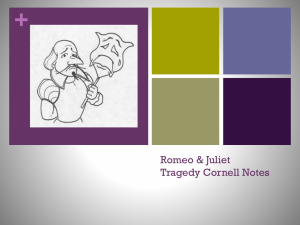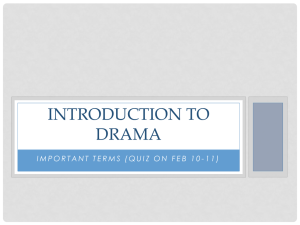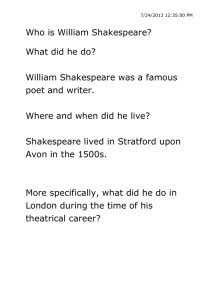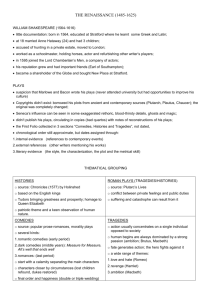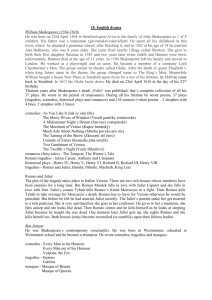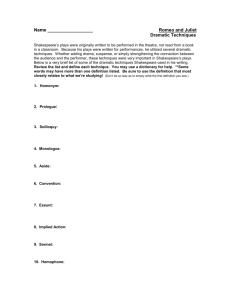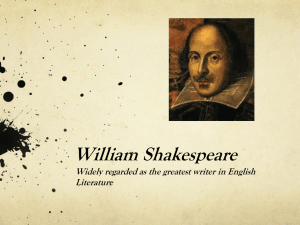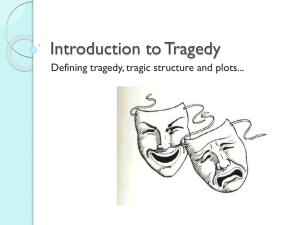William Shakespeare
advertisement
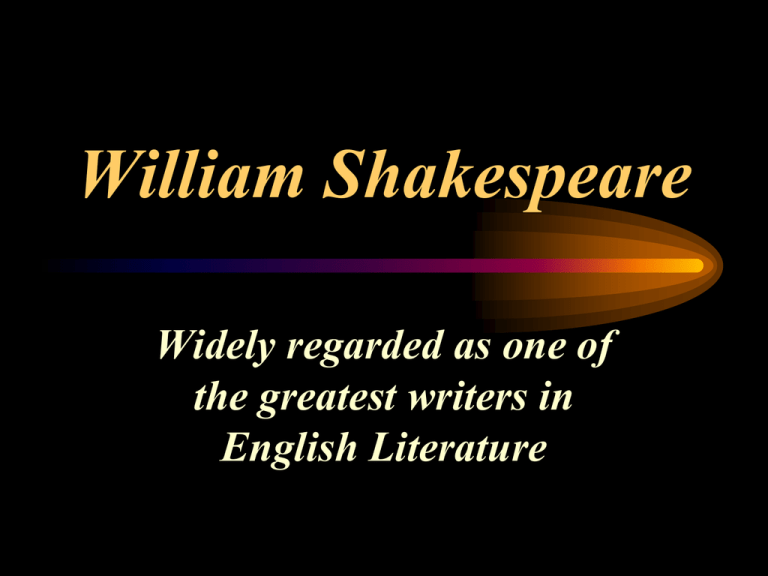
William Shakespeare Widely regarded as one of the greatest writers in English Literature His Plays Comedies Tragedies • Protagonists: • Protagonists: – The main characters are usually a young couple(s) that must overcome an obstacle • Plot: • In the characters’ pursuit of love, they get mixed up in all sorts of complicated predicaments. – The main character is an admirable hero, but he has one fatal flaw that will destroy him. In King Lear, for instance, the King’s flaw is arrogance. His ego actually topples his entire kingdom. • Plot: • Tragedies often deal with revenge, murder, war, doomed love, and political conspiracies. His plays con’t Comedies – Comedies treat heavy subjects lightly. The Bard (aka Shakespeare) used metaphors, insults, and puns to make the audience laugh and to make them think more deeply. • Love Triangles: • A love triangle happens when two people have a crush on the same person. In A Midsummer Night’s Dream, a love triangle starts a plot involving fairies, hasty getaways, magic, and a donkey – seriously! Tragedies – The audience feels powerless because the tragedy is usually avoidable. For example, if only Romeo had received the Friar’s letter, he and Juliet could have lived happily ever after! • Supernatural Beings: • Otherworldly creatures like witches and ghosts mean trouble. Hamlet, Macbeth, and Julius Caesar all have supernatural beings that spell catastrophe. His Plays Con’t Comedies Tragedies • Mistaken Identities: • Bad weather: – Confusing one character for another leads to many mishaps. For example, in Shakespeare’s Twelfth Night, Viola pretends to be her twin brother in order to get a job. When her brother shows up, things get out of hand. Ending: A comedy always ends well, usually with a marriage or two. – As a tragedy unfolds, society gets chaotic – and so does the weather. Killer storms and creepy mists are a clue that something bad is happening. Ending: Most of the characters die. Including the hero. The Play Plot Act III Crisis or Turning Point Act II Rising Action (complications) Act I Exposition Act IV Falling Action Act V Climax and Resolution Act 1 - Exposition • Establishes the setting, introduces some of the main characters, explains background, and sets up the characters’ main conflict. Act II - Rising Action • Consists of a series of complications. • These occur as the main characters take action to resolve their problems. Act III – Turning Point • The crisis, or turning point, is the moment in Act III when a choice is made by the main characters that determines the direction of the action: upward to a happy ending in a comedy or downward to sadness in a tragedy. • It can be the most dramatic and tense moment when the forces of conflict come together. Act IV – Falling Action • Presents events that result from the action taken at the turning point. • In a Tragedy, these events push the characters deeper and deeper into disaster; with each event we see the characters falling straight into tragedy. • In a Comedy, things begin to clear up and a happy resolution is in sight. Act V – Climax • The final and greatest scene occurs at the end of the play – in comedies a marriage will usually happen, while in tragedies the main characters usually die. • The loose parts of the plots are all tied up. • The play is over. Romeo and Juliet • Written about 1595 • Considered a tragedy • 17 movies, an opera, and a ballet have been created based on this play. Shakespeare • Was born in the town of StratfordUpon-Avon on the date many believe is April 23, 1564. • After Queen Elizabeth I died, the new King James I allowed Sh. & his men to be called “The King’s Men” in return for entertaining the court. Shakespeare • He died on April 23, 1616. • His last direct descendant died in 1670. • William Shakespeare is attributed with writing & collaborating on 38 plays (of them 18 are comedies & 10 are tragedies), 154 sonnets, & 5 poems between 1590 & 1613 • Two of his most famous plays were Romeo & Juliet (based on the initial poem “The Tragical Historye of Romeus and Juliet” by Arthur Brook) and Hamlet. Stage Celebrity • Actor for Lord Chamberlain’s Men (London theater co.) • Also > principal playwright for them • 1599> Lord Ch. Co. built Globe Theater where most of Sh. Play’s were performed (Sh. Was 1/5 owner & earned 10% of the total profit. The Theater • Plays produced for the general public • Roofless>open air • No artificial lighting • Courtyard surrounded by 3 levels of galleries Spectators • Wealthy got benches • “Groundlings”>poorer people stood and watched from the courtyard (“pit”) • All but wealthy were uneducated/illiterate • Wealthy women wore masks to disguise their identities • Much more interaction than today Spectators • Audience members behaved poorly in the theater. • They laughed, flirted, and fidgeted. • They gossiped to each other while waiting for the show to start. • The audience didn’t hesitate to show disappointment if they were not pleased with the performance. • They would throw rotten fruit or say unkind words. Staging Areas • Stage>platform that extended into the pit • Dressing & storage rooms in galleries behind & above stage • second-level gallery> upper stage> famous balcony scene in R & J • Trap door>ghosts • “Heavens”> angelic beings Differences • No scenery • Settings > references in dialogue • Elaborate costumes • Plenty of props • Fast-paced, colorful>2 hours! Costumes • Were very important to actors & crucial to a performance because there were no scenery. • More well-established actors/acing groups owned their own costumes that were appropriate for many roles. • Audience could distinguish the more significant roles by what the actors wore. Costumes • They used wigs, masks, & different colored suits. • They spent lots of money on costumes that was decorated with braid, embroidery, pearls, jewels, lace, & artifical flowers. • Props included flashing swords & swirling banners. Actors • Only men and boys • Young boys whose voices had not changed play women’s roles • Would have been considered indecent for a woman to appear on stage Blank Verse • Much of R & J is written in it: –unrhymed verse –iambic (unstressed, stressed) –pentameter( 5 “feet” to a line) • ends up to be 10 syllable lines Prose • Ordinary writing that is not poetry, drama, or song –Only characters in the lower social classes speak this way in Shakespeare’s plays –Why do you suppose that is? Dramatic Foil • A character whose purpose is to show off another character –Benvolio for Tybalt •look for others in R & J Monologue • One person speaking on stage > may be other character on stage too –ex > the Prince of Verona commanding the Capulets and Montagues to cease feuding Soliloquy • Long speech expressing the thoughts of a character alone on stage. In R & J, Romeo gives a soliloquy after the servant has fled and Paris has died. Aside • Words spoken, usually in an undertone not intended to be heard by all characters Pun • Shakespeare loved to use them!!! –Humorous use of a word with two meanings > sometimes missed by the reader because of Elizabethan language and sexual innuendo Direct Address • Words that tell the reader who is being addressed: • “A right fair mark, fair coz, is soonest hit.” • “Ah, my mistresses, which of you all/ Will now deny to dance?” Comic Relief • Use of comedy within literature that is NOT comedy to provide “relief” from seriousness or sadness. • In R & J, look for moments of comic relief that help “relieve” the tragedy of the situation Dramatic Irony • A contradiction between what a character thinks and what the reader/audience knows to be true Verbal Irony • Words used to suggest the opposite of what is meant Situational Irony • An event occurs that directly contradicts the expectations of the characters, the reader, or the audience The End

